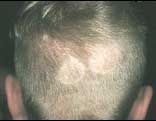
A look at the causes and the only proven treatments for Tinea Capitis (TC), a skin-level fungal infection characterized by bare patches of skin on the scalp. If you or a loved one is suffering from Tinea Capitis, it is important that you educate yourself on the condition. We have all the important information here.
What is Tinea Capitis?
Tinea Capitis is a disease caused by a fungal infection of the skin of the scalp, eyebrows and eyelashes, with a propensity for attacking hair shafts and follicles. It is also known by names such as “ringworm of the scalp” and tinea tonsurans. In the U.S. and other regions of the world, the incidence is increasing.
 Symptoms can vary. They may include a scaly, non-inflamed area of skin resembling seborrheic dermatitis, or alopecia that may progress to deep, severely inflamed abscesses with the potential for scarring and permanent hair loss. The extent of the condition depends mostly on the way the affected individual’s body reacts to the fungus.
Symptoms can vary. They may include a scaly, non-inflamed area of skin resembling seborrheic dermatitis, or alopecia that may progress to deep, severely inflamed abscesses with the potential for scarring and permanent hair loss. The extent of the condition depends mostly on the way the affected individual’s body reacts to the fungus.
The term “tinea” originally indicated larvae of insects that fed on clothes and books. Subsequently, it meant parasitic infestation of the skin. By the mid 16th century, the term was used to describe diseases of the scalp. The term “ringworm” referred to skin diseases that assumed a ring-like appearance on the skin, including tinea. The causative agents of tinea infections of the beard and scalp were first described by researchers Robert Remak and Johann Schönlein, then by physician David Gruby, during the 1830s. Approximately 50 years later, in physician Raymond Sabouraud’s dissertation, it was established that multiple species of fungi cause the disease. Simple ways to identify the type of fungus were defined and treatment using X-ray epilation was reported in 1904. Effective treatment of tinea capitis by the drug griseofulvin became available in the 1950s.
Because U.S. physicians are no longer required to report occurrences of TC to health agencies, exact numbers are not available. Internationally, the incidence of TC has dropped from 14% to 1.2% primarily due to improved hygiene and sanitary conditions. The incidence of infection has been reported at 5 times greater in boys than in girls before puberty, with a reversal of these numbers post-puberty.
Causes of Tinea Capitis
Tinea Capitis is usually the result of person-to-person transmission. The organism remains viable on combs, brushes, couches and sheets for long periods. Certain species of TC fungi are found only in certain parts of the world.
Minor bruising of the scalp occasionally provides an entry for the microscopic fungus. Infection begins as a small papule around a hair shaft on the scalp, eyebrows or eyelashes. Within a few days, the red papule becomes paler and scaly, and the hairs appear discolored, lusterless and brittle. They break off a few millimeters above the scalp skin surface. The lesion spreads, forming numerous papules in a typical ring form. Ring-formed lesions may coalesce with other infected areas. Itching usually is minimal but may be intense at times. Hair loss is common in infected areas. Inflammation may be mild or severe.
Let’s take a look at the treatments and diagnosis of Tinea Capitis:

